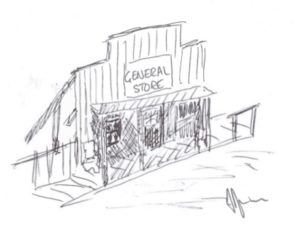Don’t Confuse Function With Service

Looks like a General Store but is there any substance behind it?
The sketch shows a general store front. Whilst it functions perfectly adequately for a film set, if you wish to buy vittles [1] you will be disappointed!
What we may think of as Service may not be. It may be just a function.
So what is the difference between a Function and a Service? Can a Service be a Function? And can a Function be a Service?
In some respects a Function is easier to describe. It is a self contained process with inputs and outputs. It could be performed by a machine or by a person or team.
A function has Utility. It is fit for use.
This is similar to a Service. A Service has Utility too, but it has a lot more besides.
The components of a service can be summed up in the following table.
| ITIL V3 | ITIL4 | |
|---|---|---|
| 1 | People | Organizations and people |
| 2 | Products | Information and technology |
| 3 | Partners | Partners and suppliers |
| 4 | Processes | Value streams and processes. |
A Service has Utility and Warranty. It is fit for use and fit for purpose. A service has a Warranty.
The components of a Service are defined in the design documents and these details will have been have agreed with the customer to form the Warranty. The warranty is a guarantee of something being fit for purpose.
A Warranty is the reason a service is so much more than a function – a service has much more going on behind the scenes, perhaps only visible in the small print.
The Service Warranty is made up of four key features:
| Warranty Aspect | Summarised Definition | |
|---|---|---|
| 1 | Availability | When/where/how and to whom is the service made available? |
| 2 | Capacity | How much of the service can used simultaneously or in a given period. For example, how many concurrent users or transactions per day? |
| 3 | Security | Can the service be trusted to protect the customer’s and users’ interests? Is it compliant? |
| 4 | Continuity | What resilience features and recovery processes are in place for when the service fails? |
The warranty is the service provider owning the specific costs and risks. It is the small print saying what risks and costs are accepted by the service provider. If there is no small print… can it be relied upon?
How does apply to your workplace? Crucially, if you provide a function and someone describes it as a Service, make sure you correct them, otherwise you may be inadvertently over-committing.
If they want it to be a service they should resource it! Or as Beyoncé would say “Put a Ring on it” [2].
Conversely, if you rely upon something and there is no warranty, be warned!
- Vittles is likely a derivation of victuals, meaning food.
- A line from Beyoncé’s hit Single Ladies.




Recent comments